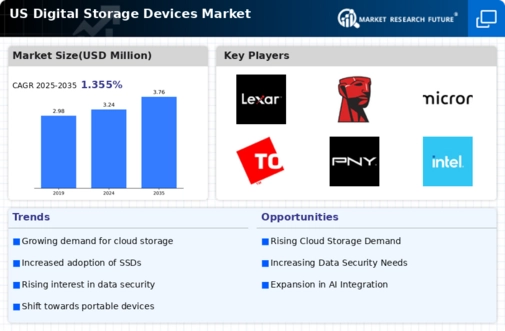The digital storage devices market is currently characterized by intense competition and rapid technological advancements. Key growth drivers include the increasing demand for data storage solutions across various sectors, such as cloud computing, artificial intelligence, and big data analytics. Major players like Western Digital (US), Seagate Technology (US), and Micron Technology (US) are strategically positioned to leverage these trends. Western Digital (US) focuses on innovation in flash storage technologies, while Seagate Technology (US) emphasizes expanding its data center solutions. Micron Technology (US) is heavily investing in memory technologies, which collectively shapes a competitive environment that is both dynamic and multifaceted.
In terms of business tactics, companies are increasingly localizing manufacturing to mitigate supply chain disruptions and optimize logistics. The market structure appears moderately fragmented, with several key players exerting considerable influence. This fragmentation allows for niche players to emerge, yet the collective strength of established companies like Intel (US) and Samsung Electronics (KR) ensures that competition remains robust and challenging for new entrants.
In November 2025, Western Digital (US) announced a strategic partnership with a leading cloud service provider to enhance its data storage solutions. This collaboration is expected to bolster Western Digital's position in the cloud storage segment, allowing it to offer more integrated solutions tailored to enterprise needs. Such partnerships are indicative of a broader trend where companies seek to align their offerings with the evolving demands of digital transformation.
In October 2025, Seagate Technology (US) unveiled its latest line of high-capacity hard drives designed specifically for AI applications. This move not only showcases Seagate's commitment to innovation but also highlights the growing intersection of storage technology and artificial intelligence. By catering to this niche, Seagate is likely to capture a significant share of the market that is increasingly reliant on AI-driven data processing.
In September 2025, Micron Technology (US) launched a new series of memory chips aimed at enhancing performance in data-intensive applications. This initiative underscores Micron's focus on advancing memory technology to meet the demands of modern computing environments. The introduction of these chips is expected to solidify Micron's competitive edge in the memory market, particularly as data generation continues to surge.
As of December 2025, current competitive trends are heavily influenced by digitalization, sustainability, and the integration of AI technologies. Strategic alliances are becoming increasingly vital, as companies recognize the need to collaborate to stay ahead in a rapidly evolving landscape. The shift from price-based competition to a focus on innovation, technology, and supply chain reliability is evident. Moving forward, differentiation will likely hinge on the ability to deliver cutting-edge solutions that not only meet but anticipate the needs of consumers and businesses alike.





















Leave a Comment